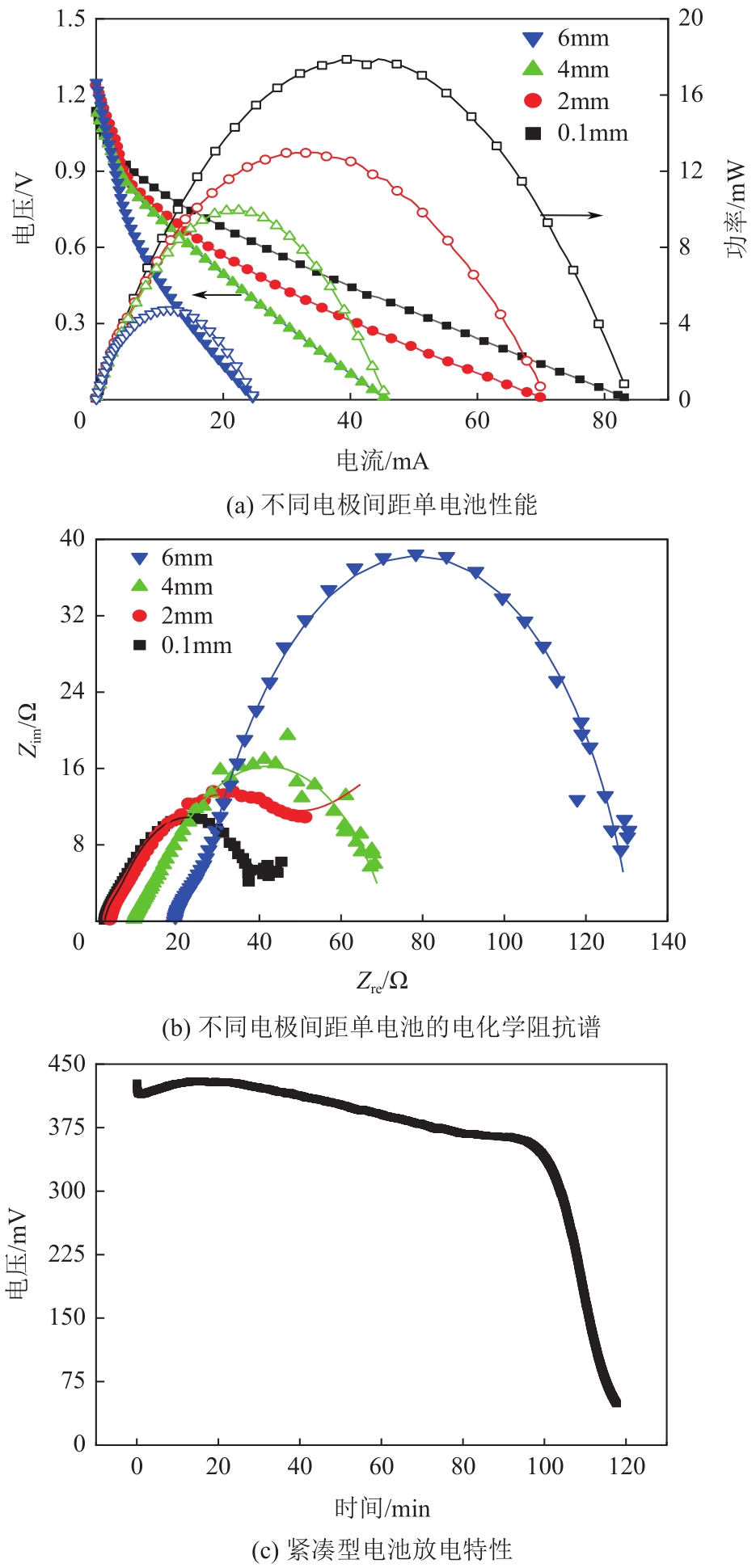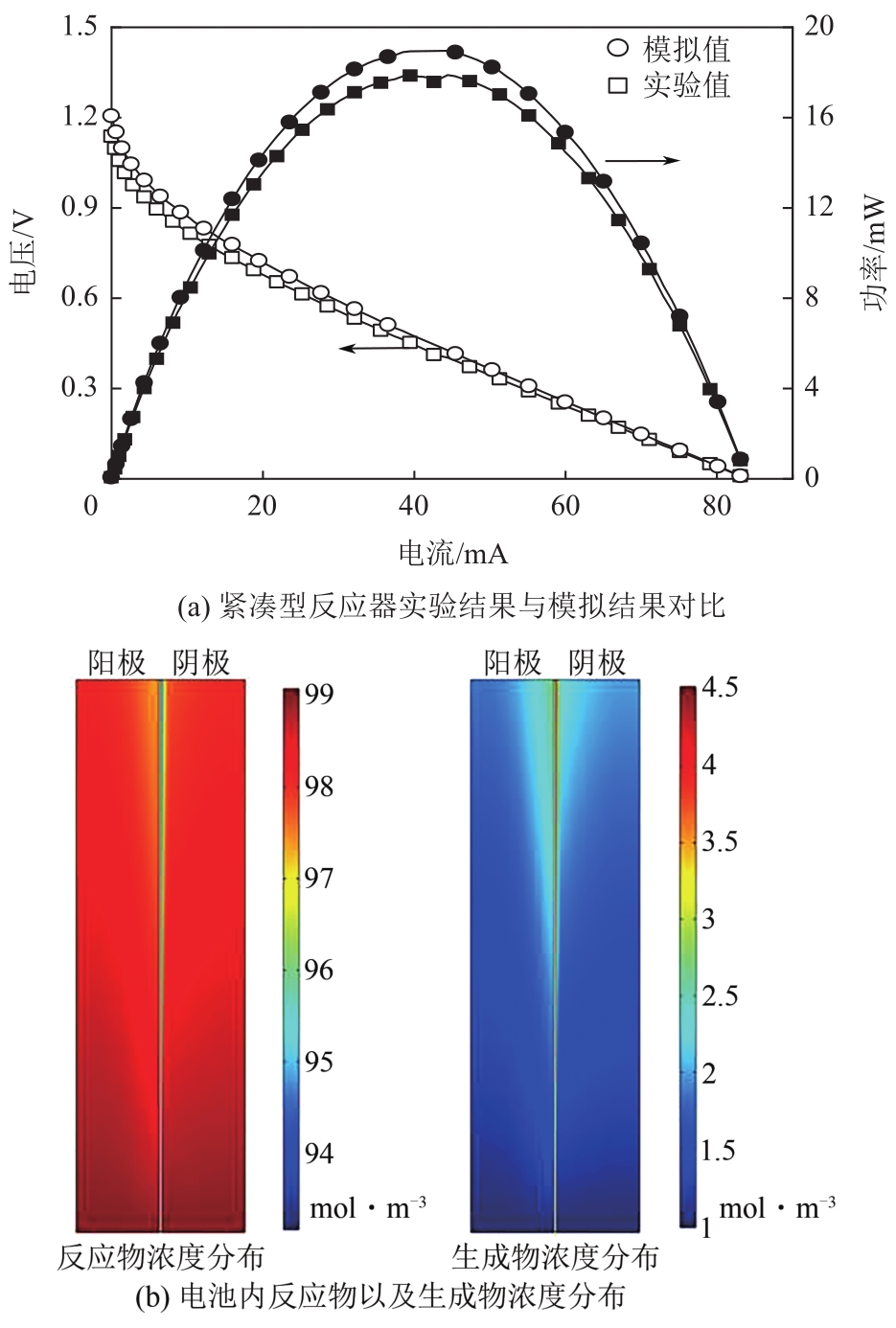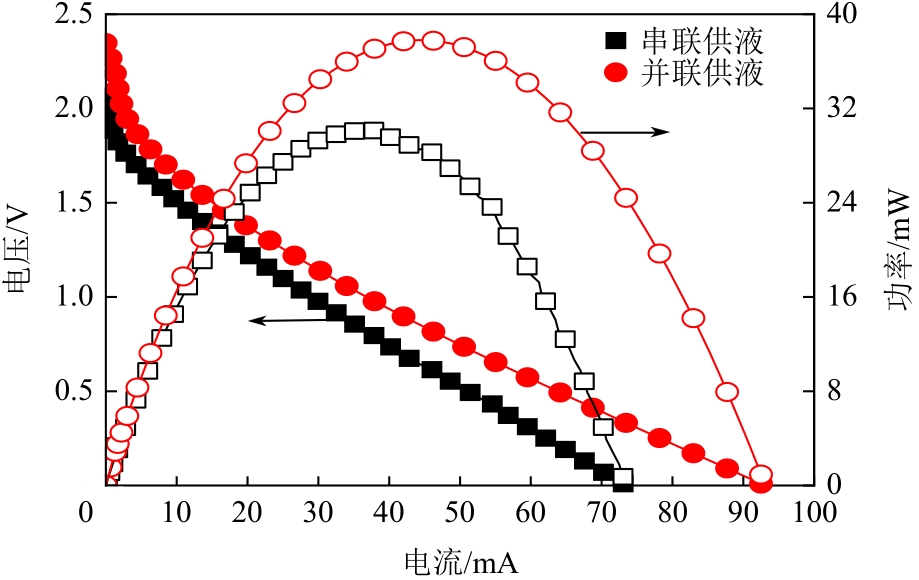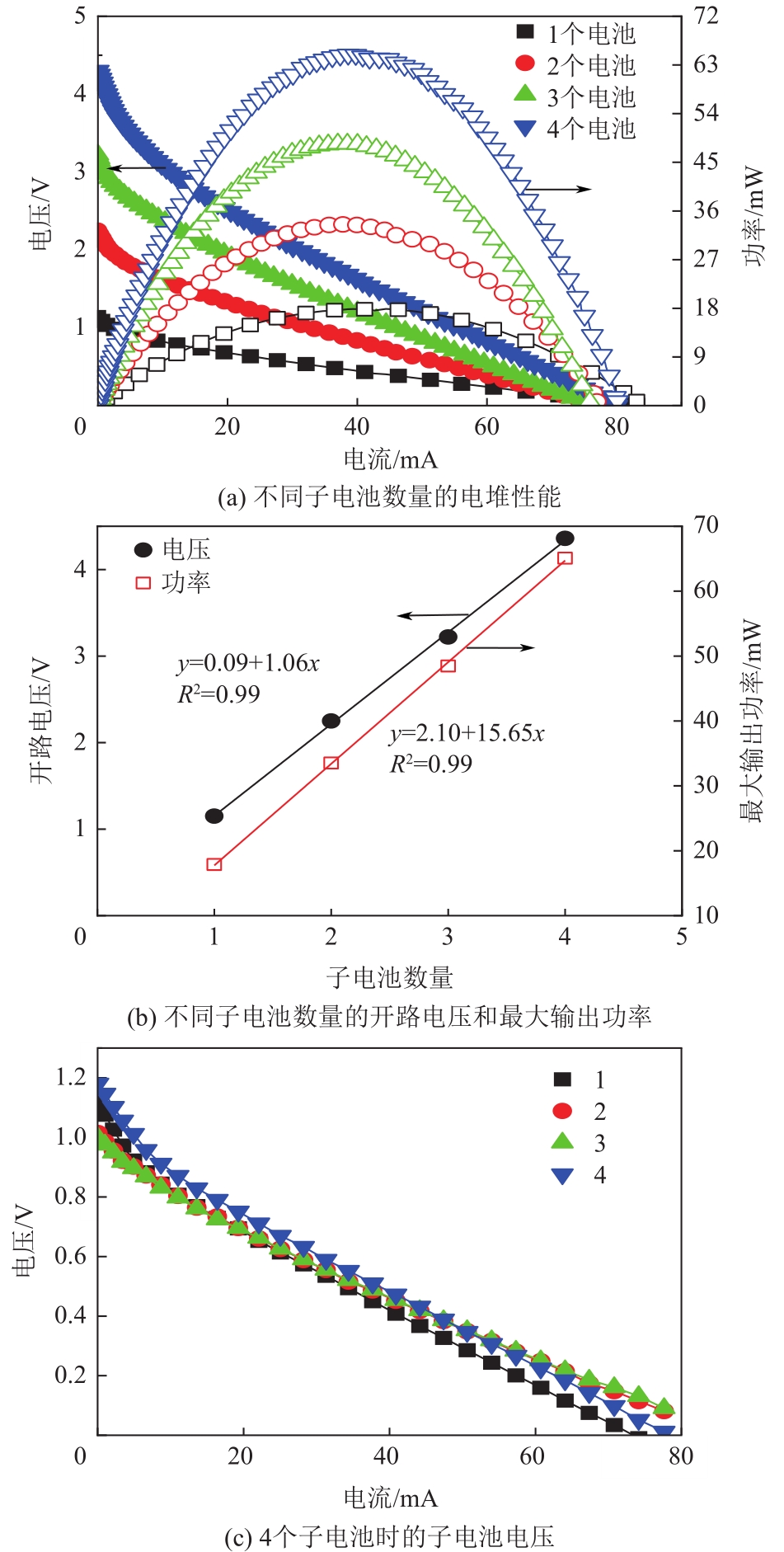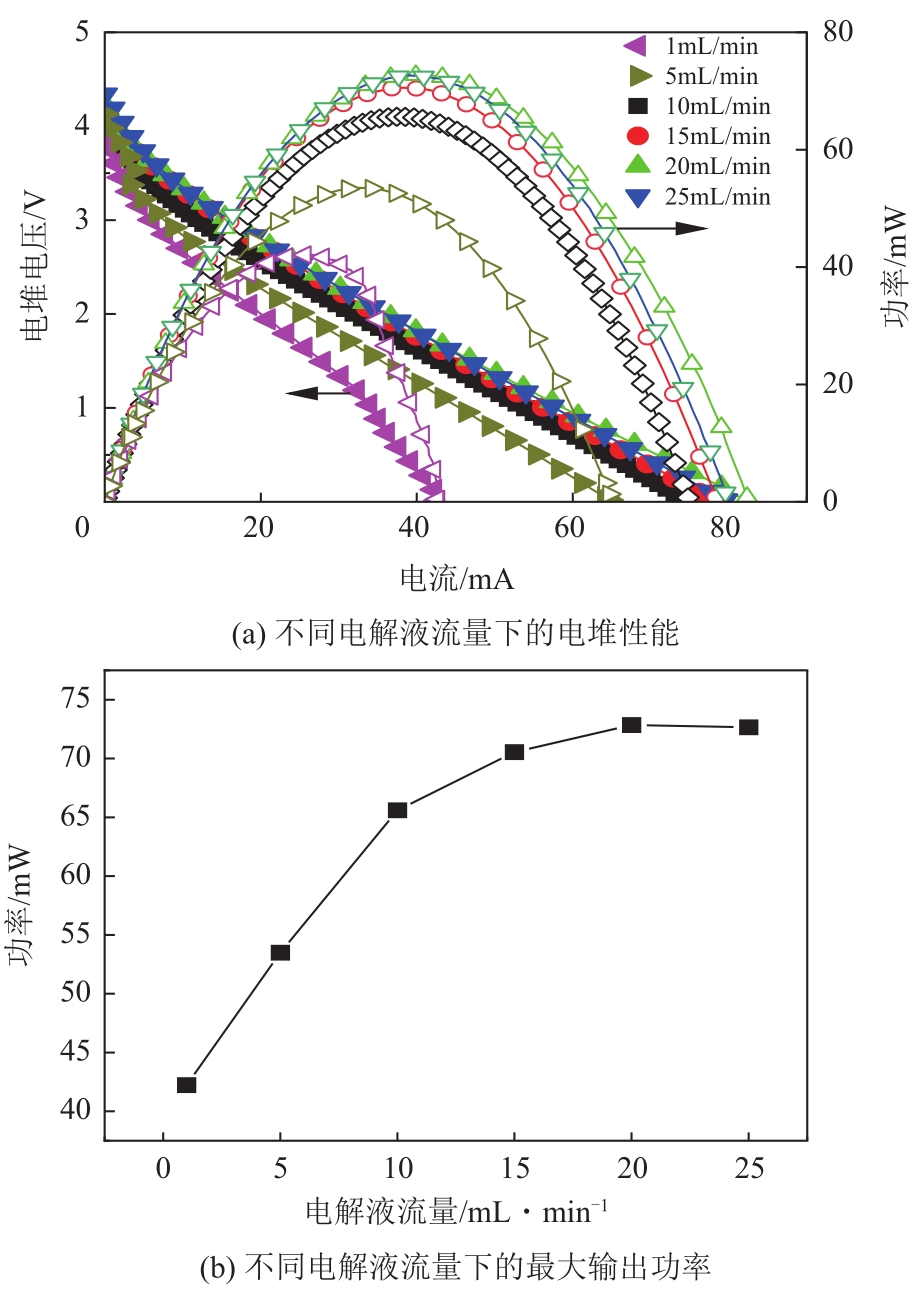Chemical Industry and Engineering Progress ›› 2023, Vol. 42 ›› Issue (8): 4238-4246.DOI: 10.16085/j.issn.1000-6613.2022-1820
• Energy processes and technology • Previous Articles Next Articles
Performance of series stack of non-aqueous nano slurry thermally regenerative flow batteries
LI Dong1,2( ), WANG Qianqian1,2, ZHANG Liang1,2(
), WANG Qianqian1,2, ZHANG Liang1,2( ), LI Jun1,2, FU Qian1,2, ZHU Xun1,2, LIAO Qiang1,2
), LI Jun1,2, FU Qian1,2, ZHU Xun1,2, LIAO Qiang1,2
- 1.Key Laboratory of Low-grade Energy Utilization Technologies and Systems, Chongqing University, Ministry of Education, Chongqing 400030, China
2.Institute of Engineering Thermophysics, Chongqing University, Chongqing 400030, China
-
Received:2022-09-29Revised:2023-01-17Online:2023-09-19Published:2023-08-15 -
Contact:ZHANG Liang
非水系纳米流体热再生液流电池串联堆性能特性
李洞1,2( ), 王倩倩1,2, 张亮1,2(
), 王倩倩1,2, 张亮1,2( ), 李俊1,2, 付乾1,2, 朱恂1,2, 廖强1,2
), 李俊1,2, 付乾1,2, 朱恂1,2, 廖强1,2
- 1.重庆大学低品位能源利用及系统教育部重点实验室,重庆 400030
2.重庆大学工程热物理研究所,重庆 400030
-
通讯作者:张亮 -
作者简介:李洞(1998—),男,硕士研究生,研究方向为电化学能源转换。E-mail:20173242@cqu.edu.cn。 -
基金资助:国家自然科学基金面上项目(51976018);国家自然科学基金创新研究群体项目(52021004)
CLC Number:
Cite this article
LI Dong, WANG Qianqian, ZHANG Liang, LI Jun, FU Qian, ZHU Xun, LIAO Qiang. Performance of series stack of non-aqueous nano slurry thermally regenerative flow batteries[J]. Chemical Industry and Engineering Progress, 2023, 42(8): 4238-4246.
李洞, 王倩倩, 张亮, 李俊, 付乾, 朱恂, 廖强. 非水系纳米流体热再生液流电池串联堆性能特性[J]. 化工进展, 2023, 42(8): 4238-4246.
share this article
Add to citation manager EndNote|Ris|BibTeX
URL: https://hgjz.cip.com.cn/EN/10.16085/j.issn.1000-6613.2022-1820
| 参数 | 数值 |
|---|---|
| 电极高度H/mm | 20 |
| 电极宽度W/mm | 20 |
| 腔室及电极厚度L/mm | 3 |
| AEM厚度T/mm | 0.1 |
| 参数 | 数值 |
|---|---|
| 电极高度H/mm | 20 |
| 电极宽度W/mm | 20 |
| 腔室及电极厚度L/mm | 3 |
| AEM厚度T/mm | 0.1 |
| 参数 | 数值 | 来源 |
|---|---|---|
| Cu2+扩散系数D(Cu2+)/m2·s-1 | 1.5×10-9 | 文献[ |
| Cu(CH3CN)4+扩散系数D[Cu(CH3CN)4+]/m2·s-1 | 2.4×10-10 | 测量 |
| CH3CN扩散系数D(CH3CN)/m2·s-1 | 9.3×10-9 | 文献[ |
| Cu扩散系数D(Cu)/m2·s-1 | 1.33×10-9 | 测量 |
| BF4-扩散系数D(BF4-)/m2·s-1 | 1.1×10-9 | 文献[ |
| 电极孔隙率ε | 0.93 | — |
| 电极活性比表面积aV/m2·m-3 | 3504 | 测量 |
| 操作温度T/K | 298.15 | 测量 |
| 阳极反应速度常量K0a/m·s-1 | 2.5×10-7 | 文献[ |
| 阴极反应速度常量K0c/m·s-1 | 7×10-7 | 文献[ |
| Cu2+初始浓度c(Cu2+)/mol·L-1 | 0.1 | — |
| CH3CN初始浓度c(CH3CN)/mol·L-1 | 4 | — |
| Cu初始浓度c(Cu)/mol·L-1 | 0.1 | — |
| BF4-初始浓度c(BF4-)/mol·L-1 | 0.15 | — |
| 0.55 | — | |
| 0.45 | — | |
| 0.55 | — | |
| 0.45 | — |
| 参数 | 数值 | 来源 |
|---|---|---|
| Cu2+扩散系数D(Cu2+)/m2·s-1 | 1.5×10-9 | 文献[ |
| Cu(CH3CN)4+扩散系数D[Cu(CH3CN)4+]/m2·s-1 | 2.4×10-10 | 测量 |
| CH3CN扩散系数D(CH3CN)/m2·s-1 | 9.3×10-9 | 文献[ |
| Cu扩散系数D(Cu)/m2·s-1 | 1.33×10-9 | 测量 |
| BF4-扩散系数D(BF4-)/m2·s-1 | 1.1×10-9 | 文献[ |
| 电极孔隙率ε | 0.93 | — |
| 电极活性比表面积aV/m2·m-3 | 3504 | 测量 |
| 操作温度T/K | 298.15 | 测量 |
| 阳极反应速度常量K0a/m·s-1 | 2.5×10-7 | 文献[ |
| 阴极反应速度常量K0c/m·s-1 | 7×10-7 | 文献[ |
| Cu2+初始浓度c(Cu2+)/mol·L-1 | 0.1 | — |
| CH3CN初始浓度c(CH3CN)/mol·L-1 | 4 | — |
| Cu初始浓度c(Cu)/mol·L-1 | 0.1 | — |
| BF4-初始浓度c(BF4-)/mol·L-1 | 0.15 | — |
| 0.55 | — | |
| 0.45 | — | |
| 0.55 | — | |
| 0.45 | — |
| 1 | LU H Y, PRICE L, ZHANG Q. Capturing the invisible resource: Analysis of waste heat potential in Chinese industry[J]. Applied Energy, 2016, 161: 497-511. |
| 2 | 陈光辉, 李升大, 陶少辉, 等. 焦炉余热综合利用研究进展[J]. 化工进展, 2018, 37(10): 3799-3805. |
| CHEN Guanghui, LI Shengda, TAO Shaohui, et al. Application and research of process of comprehensive utilization of coke oven waste heat[J]. Chemical Industry and Engineering Progress, 2018, 37(10): 3799-3805. | |
| 3 | 王明涛, 刘启一, 张百浩. 冷凝条件对基于混合工质的内燃机余热有机朗肯循环热力性能的影响[J]. 化工进展, 2018, 37(8): 2927-2934. |
| WANG Mingtao, LIU Qiyi, ZHANG Baihao. Effects of condensation condition on cycle performance of the organic Rankine cycle (ORC) for recovering waste heat of engine using zeotropic mixtures[J]. Chemical Industry and Engineering Progress, 2018, 37(8): 2927-2934. | |
| 4 | 王治红, 丁晓明, 吴明鸥, 等. 有机朗肯循环在多品位余热发电中的应用[J]. 化工进展, 2019, 38(5): 2189-2196. |
| WANG Zhihong, DING Xiaoming, WU Ming’ou, et al. Application of organic Rankine cycle in multi-grade waste heat power generation[J]. Chemical Industry and Engineering Progress, 2019, 38(5): 2189-2196. | |
| 5 | 张进华, 秦强, 赵香龙, 等. 低品位工业余热利用技术及研究进展[J]. 能源科技, 2022, 20(4): 86-92. |
| ZHANG Jinhua, QIN Qiang, ZHAO Xianglong, et al. Technologies for low-grade industrial waste heat utilization and research progress[J]. Energy Science and Technology, 2022, 20(4): 86-92. | |
| 6 | 李志广, 苏畅, 赵学谦. 基于半导体温差发电的暖气小夜灯[J]. 电源技术, 2020, 44(1): 83-84. |
| LI Zhiguang, SU Chang, ZHAO Xueqian. Night light on heating installation based on semiconductor thermoelectric power generation[J]. Chinese Journal of Power Sources, 2020, 44(1): 83-84. | |
| 7 | 邓会宁, 何云飞, 胡柏松, 等. 反电渗析法盐差能发电用离子交换膜研究进展[J]. 化工进展, 2017, 36(1): 224-231. |
| DENG Huining, HE Yunfei, HU Baisong, et al. Progress in ion exchange membranes for reverse electrodialysis[J]. Chemical Industry and Engineering Progress, 2017, 36(1): 224-231. | |
| 8 | HUO Dongxing, TIAN Hua, SHU Gequn, et al. Progress and prospects for low-grade heat recovery electrochemical technologies[J]. Sustainable Energy Technologies and Assessments, 2022, 49: 101802. |
| 9 | RAHIMI M, STRAUB A P, ZHANG F, et al. Emerging electrochemical and membrane-based systems to convert low-grade heat to electricity[J]. Energy & Environmental Science, 2018, 11(2): 276-285. |
| 10 | RAHIMI M, SCHOENER Z, ZHU X P, et al. Removal of copper from water using a thermally regenerative electrodeposition battery[J]. Journal of Hazardous Materials, 2017, 322: 551-556. |
| 11 | ZHANG Fang, LIU Jia, YANG Wulin, et al. A thermally regenerative ammonia-based battery for efficient harvesting of low-grade thermal energy as electrical power[J]. Energy & Environmental Science, 2015, 8(1): 343-349. |
| 12 | ZHANG F, LABARGE N, YANG W L, et al. Enhancing low-grade thermal energy recovery in a thermally regenerative ammonia battery using elevated temperatures[J]. ChemSusChem, 2015, 8(6): 1043-1048. |
| 13 | ZHU X P, RAHIMI M, GORSKI C A, et al. A thermally-regenerative ammonia-based flow battery for electrical energy recovery from waste heat[J]. ChemSusChem, 2016, 9(8): 873-879. |
| 14 | PALAKKAL V M, THU N, PHUC N, et al. High power thermally regenerative ammonia-copper redox flow battery enabled by a zero gap cell design, low-resistant membranes, and electrode coatings[J]. ACS Applied Energy Materials, 2020, 3(5): 4787-4798. |
| 15 | WANG Weiguang, SHU Gequn, TIAN Hua, et al. A bimetallic thermally-regenerative ammonia-based flow battery for low-grade waste heat recovery[J]. Journal of Power Sources, 2019, 424: 184-192. |
| 16 | RAHIMI M, KIM T Y, GORSKI C A, et al. A thermally regenerative ammonia battery with carbon-silver electrodes for converting low-grade waste heat to electricity[J]. Journal of Power Sources, 2018, 373: 95-102. |
| 17 | RAHIMI M, D’ANGELO A, GORSKI C A, et al. Electrical power production from low-grade waste heat using a thermally regenerative ethylenediamine battery[J]. Journal of Power Sources, 2017, 351: 45-50. |
| 18 | ZHANG Liang, LI Yanxiang, ZHU Xun, et al. Copper foam electrodes for increased power generation in thermally regenerative ammonia-based batteries for low-grade waste heat recovery[J]. Industrial & Engineering Chemistry Research, 2019, 58(17): 7408-7415. |
| 19 | SHI Yu, ZHANG Liang, LI Jun, et al. Cu/Ni composite electrodes for increased anodic coulombic efficiency and electrode operation time in a thermally regenerative ammonia-based battery for converting low-grade waste heat into electricity[J]. Renewable Energy, 2020, 159: 162-171. |
| 20 | CHEN Pengyu, ZHANG Liang, SHI Yu, et al. Biomass waste-derived hierarchical porous composite electrodes for high-performance thermally regenerative ammonia-based batteries[J]. Journal of Power Sources, 2022, 517: 230719. |
| 21 | ZHANG Yongsheng, SHI Yu, ZHANG Liang, et al. A fluidized-bed reactor for enhanced mass transfer and increased performance in thermally regenerative batteries for low-grade waste heat recovery[J]. Journal of Power Sources, 2021, 495: 229815. |
| 22 | ZHANG Yongsheng, ZHANG Liang, LI Jun, et al. Performance of a thermally regenerative ammonia-based flow battery with 3D porous electrodes: Effect of reactor and electrode design[J]. Electrochimica Acta, 2020, 331: 135442. |
| 23 | VICARI F, ANGELO A D, KOUKO Y, et al. On the regeneration of thermally regenerative ammonia batteries[J]. Journal of Applied Electrochemistry, 2018, 12(48): 1381-1388. |
| 24 | 石雨, 张亮, 李俊, 等. 热再生电池氨再生过程强化[J]. 化工学报, 2020, 71(S2): 253-258. |
| SHI Yu, ZHANG Liang, LI Jun, et al. Enhanced ammonia regeneration of thermal regenerated batteries[J]. CIESC Journal, 2020, 71(S2): 253-258. | |
| 25 | 石雨, 蒋强, 张亮, 等. 再生反应器液面高度对热再生电池性能的影响[J]. 化工学报, 2021, 72(8): 4354-4360. |
| SHI Yu, JIANG Qiang, ZHANG Liang, et al. Effect of liquid height in regeneration reactor on performance of thermal regeneration battery[J]. CIESC Journal, 2021, 72(8): 4354-4360. | |
| 26 | LUO Jielin, WANG Zeming, WU Hao, et al. Vapor pressure measurement of electrolyte solution and its impact on regeneration process in TRAB[J]. Case Studies in Thermal Engineering, 2022, 36: 102201. |
| 27 | LU Zhiqiang, SHI Yu, ZHANG Liang, et al. Ammonia crossover in thermally regenerative ammonia-based batteries for low-grade waste heat recovery[J]. Journal of Power Sources, 2022, 548: 232085. |
| 28 | ZHANG Yongsheng, SHI Yu, ZHANG Liang, et al. Graphene oxide modified membrane for alleviated ammonia crossover and improved electricity generation in thermally regenerative batteries[J]. Chinese Chemical Letters, 2023, 34(2): 107704. |
| 29 | MAYE S, GIRAULT H H, PELJO P. Thermally regenerative copper nanoslurry flow batteries for heat-to-power conversion with low-grade thermal energy[J]. Energy & Environmental Science, 2020, 13(7): 2191-2199. |
| 30 | 卢志强, 张亮, 李俊, 等. 不同负载下热再生氨电池产电及Cu2+去除特性[J]. 化工进展, 2022, 41(6): 3341-3349. |
| LU Zhiqiang, ZHANG Liang, LI Jun, et al. Effects of load on power generation and copper removal rate of thermally regenerative ammonia-based batteries[J]. Chemical Industiy and Engineering Progress, 2022, 41(6): 3341-3349. | |
| 31 | SENN J K, KRATOCHVIL B. Standard potential of the copper (Ⅱ)-(Ⅰ) couple in acetonitrile[J]. Analytical Chemistry, 1972, 3(44): 585-588. |
| 32 | ZHANG Liang, LU Zhiqiang, CHEN Pengyu, et al. An environmentally friendly gradient treatment system of copper-containing wastewater by coupling thermally regenerative battery and electrodeposition cell[J]. Separation and Purification Technology, 2022, 295: 121243. |
| 33 | ZHAO Taolin, HUANG Xiyun, MENG Yu, et al. In situ construction of graded porous carbon matrix to strengthen structural stability of NiFe2O4 nanoparticles as high-capacity anodes of Li-ion batteries[J]. Journal of Materials Science, 2022, 57(31): 14979-14992. |
| 34 | ZHANG Shijie, ZHANG Yongshang, SHAO Guosheng, et al. Bio-inspired construction of electrocatalyst decorated hierarchical porous carbon nanoreactors with enhanced mass transfer ability towards rapid polysulfide redox reactions[J]. Nano Research, 2021, 14(11): 3942-3951. |
| 35 | RAJAEI H, HAVERKORT J W. Compact monopolar electrochemical stack designs using electrode arrays or corrugated electrodes[J]. Electrochimica Acta, 2020, 332: 135470. |
| [1] | XU Jiaheng, LI Yongsheng, LUO Chunhuan, SU Qingquan. Optimization of methanol steam reforming process [J]. Chemical Industry and Engineering Progress, 2023, 42(S1): 41-46. |
| [2] | SHAO Boshi, TAN Hongbo. Simulation on the enhancement of cryogenic removal of volatile organic compounds by sawtooth plate [J]. Chemical Industry and Engineering Progress, 2023, 42(S1): 84-93. |
| [3] | CHEN Kuangyin, LI Ruilan, TONG Yang, SHEN Jianhua. Structure design of gas diffusion layer in proton exchange membrane fuel cell [J]. Chemical Industry and Engineering Progress, 2023, 42(S1): 246-259. |
| [4] | YANG Hanyue, KONG Lingzhen, CHEN Jiaqing, SUN Huan, SONG Jiakai, WANG Sicheng, KONG Biao. Decarbonization performance of downflow tubular gas-liquid contactor of microbubble-type [J]. Chemical Industry and Engineering Progress, 2023, 42(S1): 197-204. |
| [5] | HUANG Yiping, LI Ting, ZHENG Longyun, QI Ao, CHEN Zhenglin, SHI Tianhao, ZHANG Xinyu, GUO Kai, HU Meng, NI Zeyu, LIU Hui, XIA Miao, ZHU Kai, LIU Chunjiang. Hydrodynamics and mass transfer characteristics of a three-stage internal loop airlift reactor [J]. Chemical Industry and Engineering Progress, 2023, 42(S1): 175-188. |
| [6] | SHENG Weiwu, CHENG Yongpan, CHEN Qiang, LI Xiaoting, WEI Jia, LI Linge, CHEN Xianfeng. Operating condition analysis of the microbubble and microdroplet dual-enhanced desulfurization reactor [J]. Chemical Industry and Engineering Progress, 2023, 42(S1): 142-147. |
| [7] | LIU Xuanlin, WANG Yikai, DAI Suzhou, YIN Yonggao. Analysis and optimization of decomposition reactor based on ammonium carbamate in heat pump [J]. Chemical Industry and Engineering Progress, 2023, 42(9): 4522-4530. |
| [8] | LU Shaojie, LIU Jia, JI Qianzhu, LI Ping, HAN Yueyang, TAO Min, LIANG Wenjun. Preparation of diatomaceous earth-based composite filler and its xylene removal performance by a biotrickling filter [J]. Chemical Industry and Engineering Progress, 2023, 42(7): 3884-3892. |
| [9] | LI Ruidong, HUANG Hui, TONG Guohu, WANG Yueshe. Hygroscopic properties and corrosion behavior of ammonium salt in a crude oil distillation column [J]. Chemical Industry and Engineering Progress, 2023, 42(6): 2809-2818. |
| [10] | ZHANG Kai, JIN Hanyu, LIU Siyu, WANG Shuai. Simulation of mass transfer process under the bubble interaction in bubbling fluidization [J]. Chemical Industry and Engineering Progress, 2023, 42(6): 2828-2835. |
| [11] | MA Zhejie, ZHANG Wenli, ZHAO Xuankai, LI Ping. Progress on the influence of oxygen mass transfer resistance in PEMFC cathode catalyst layer [J]. Chemical Industry and Engineering Progress, 2023, 42(6): 2860-2873. |
| [12] | CHEN Weiliang, GAO Xin, LI Hong, LI Xingang. Influence mechanism of skeleton structure of foamed SiC corrugated structured packing on the mass transfer performance [J]. Chemical Industry and Engineering Progress, 2023, 42(5): 2289-2297. |
| [13] | LI Xue, WANG Yanjun, WANG Yuchao, TAO Shengyang. Recent advances in bionic surfaces for fog collection [J]. Chemical Industry and Engineering Progress, 2023, 42(5): 2486-2503. |
| [14] | TIAN Qikai, ZHENG Haiping, ZHANG Shaobin, ZHANG Jing, YU Ziyi. Advances in mixing enhanced microfluidic channels [J]. Chemical Industry and Engineering Progress, 2023, 42(4): 1677-1687. |
| [15] | SHANG Yu, XIAO Man, CUI Qiufang, TU Te, YAN Shuiping. Recovery characteristics of PVDF/BN-OH flat composite membrane for waste heat of hot stripped gas in CO2 capture process [J]. Chemical Industry and Engineering Progress, 2023, 42(3): 1618-1628. |
| Viewed | ||||||
|
Full text |
|
|||||
|
Abstract |
|
|||||


